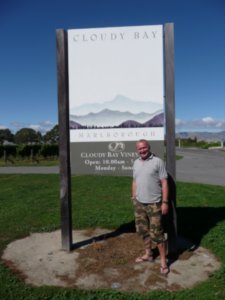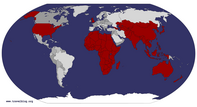Advertisement
Published: March 28th 2009

 Me outside Cloudy Bay
Me outside Cloudy Bay
This is one of New Zealand's Finest WineriesOn our way to Kaikoura we stopped at Hunters Vineyard for some early morning wine tasting which is a great way to start the day. Then l remembered that my Uncles favourite wine came from New Zealand and l could not believe that the vineyard was only a short 5 minute drive from the Hunters Vineyard. Dave our tour guide was happy to drive me there and within minutes l was tasting some great white and sparkling wines from one of New Zealand's finest vineyards.
During our 4 hour drive we passed some o the most amazing coast line with huge waves crashing into the shore. We stopped for lunch at a great restaurant and had Giant Green Mussels with crusty toasted bread. We also stopped at a few seal colonies, with adult and baby pups.
We arrived in Kaikoura and booked into our hostel overlooking the bay and a short walk into town. Yet again the weather is the factor in New Zealand and some of the activities that we planned during our trip. We later found out that the Whale watching boats hadn’t been out for a few days due to the huge waves about 2km from
the shore, this was a great shame as l was looking forward to seeing the sperm whales that spend most of their time off the coast of Kaikoura. We then decided to do the Dolphin Encounter that took you out swimming with the famous Dusky dolphin that inhabits the coastline.
We awoke the following morning to find that the weather was not the best that we had experienced over the past few days. We left to take the 2/3 minute drive to the Dolphin centre and were told that we could be taken out for the morning but may not be able to swim with them. So after getting changed into our wetsuits and sized up for our flippers, snorkels etc we sat and watched a short film about the dolphins and what to do and not.
We then took a bus ride to the harbour and we were lucky that the whole of our group were on one boat. The powerful speed boat then left the harbour and within minutes the giant waves had the group riding the roller coaster on the waves. Not long after a couple of people were using the complementary sick buckets at
the back of the boat. Then from nowhere the skipper called out that we had spotted the rarest Dolphin in these waters, the Hector Dolphin which is also the smallest Dolphin in the world.
The Dolphins Dusky & Hector Kaikoura is blessed by having a variety of marine mammals and a large variety of seabirds (pelagics) within close proximity of its shores. By far the most common marine mammals found in Kaikoura are the dusky dolphins and the sperm whales.
The dusky dolphin (Lagenorhynchus obscurus) belongs to a group known collectively as cetaceans; this comprises all whales, dolphins and porpoises. The word cetacean is derived from the Latin cetus (a large sea animal) and the Greek ketos (sea monster).
There are currently 81 recognised species of cetacean; these comprise 11 species of baleen whales and 70 species of toothed whales, which includes all the dolphins and porpoises. The dolphin family, known as Delphinidae, is made up of 33 different members.
In New Zealand the dusky dolphin is commonly found along the east coast of the South Island. Dusky dolphins are also found in other temperate waters of the world, namely
the east and west coasts of southern South America, especially Argentina, off the west coast of South Africa (in the cool waters of the Benguela Current) and around the oceanic islands of Tristan de Cunha and Amsterdam Islands.
In the Kaikoura region the dusky dolphin appears year round with a variation between summer and winter movements and habits. In the summer months of October to April the duskies will move in from offshore on a daily basis, to the inshore waters on the southern side of the Kaikoura Peninsula. During the winter months of May to September, the duskies are located further offshore and do not come in as close to shore as in summer.
Dusky dolphins are very gregarious and highly social, living together in groups called pods, which in the Kaikoura region can consist of individuals numbering anywhere from 100 to 800 in each pod. In autumn and winter, pod sizes can even be greater, sometimes numbering in the thousands. For this reason, Kaikoura is recognised as one of the best places in the world to regularly encounter wild dolphins in their natural environment.
Life span of the dusky dolphin is thought to be anywhere
between 20 to 25 years. Maximum size is between 165cm and 195cm in New Zealand and they weigh anywhere between 60 to 90 kg in weight. The same species in South America are known to grow larger, with records of dolphins just over 2 metres in length.
Mating of dusky dolphins usually takes place during spring, summer and autumn, with not all mating being for reproductive purposes. A lot of mating is done purely as a means of socialising or maybe just for pure enjoyment. Dusky dolphins do not develop pair bonds and their mating habits could be viewed as promiscuous, with adult males competing for mating access to females. Males will pursue the female, each male often mating several times with the same female in a matter of minutes. In Kaikoura, new calves are born in the spring, anywhere from September to December after a gestation period of about 11 months.
The dusky dolphins are reputed to be amongst the most acrobatic of the dolphin species, and their spectacular leaps, jumps, side slaps and back flips, bring shouts of joy to most that go out to witness their wild and free behaviour. One of the most spectacular
leaps performed by the duskies is its trademark somersault and the duskies will often repeat these acrobatic leaps time and again.
The question is often asked “Why do the dolphins jump?” Although we do not know for sure why the duskies display such exuberance we believe that this is simply a reflection of their personality.
One of the smallest marine dolphins in the world, Hector’s dolphins grows no more than 1.5 m in length. Only found in New Zealand’s waters, this distinctive grey dolphin with black and white markings and a round dorsal fin is the most easily recognised species of dolphin in NZ. The Hector's dolphin is the rarest dolphin in the world - not a title to envy!.
The Hector’s dolphin was named after Sir James Hector. Sir James was the curator of the Colonial Museum in Wellington (now the museum of New Zealand - Te Papa). He examined the first specimen found of the dolphin. Sir James lived from 1834 to 1907. He was the most influential New Zealand scientist of his time. This means that he was really onto it when it came to science and was really into learning about nature -
cool.
It may not be easy to tell which dolphin is ‘flying’ by when you see them from the shore or from a boat, so here’s some help…
The Hector’s dolphin is much smaller than other dolphins seen in New Zealand waters. An adult Hector’s dolphin grows to a length of 1.2 to 1.4 metres, compared with 4 metres for the bottlenose, 3.4 metres for the striped dolphins and the Dusky dolphins 2 metres. Also, the Hector’s is a little rounder than other New Zealand dolphins.
The Hector’s does not have a bottle-shaped snout. The forehead of the Hector’s slopes down to the tip, so it does not create a protruding beak like the bottlenose dolphin.
It has a small, rounded dorsal fin - all other species of dolphin found in New Zealand waters have crescent shaped fins that are more pointed than the Hector's.
The colour scheme of the Hector’s dolphin is well defined with areas of grey, black and white.
The sides of the head, the flippers, dorsal fin and the tail are all black. The belly is white except for a small area between the flippers. There is also a distinctive

 Daddy Seal
Daddy Seal
Hundreds of seals along the coast linefinger-like swoosh of white that extends from the belly, along the flanks towards the tail. The rest of the body is grey.
But l wanna go swim with them! Unfortunately the sea were we spotted the main group of around 300 Dusky Dolphins was too murky for us to enjoy swimming with these amazing animals, we could have done if we really wanted but as our guide told us that once in the sea we would not be able to see them unless they were about 5 inches in front of us. So we watched them from the comfort of the boat and with all the Dusky's and even a few Hectors in amongst the group it was not long before a few were jumping out of the sea and giving us the aerial display that these guys are famous for. After about an hour it was time to turn the boat around to make our way back to the shore, with a much needed mug of hot chocolate and ginger nut cookies. One the way we stopped at a Seal Colony rock that this tour operator take people to swim with the Seals and once
back to the harbour we were lucky to receive a refund on the tour as we were not able to swim in the sea with the Dolphins.
You never know who's behind you in a queue! Whilst in the queue to receive my refund l heard my name being called out from behind me and l could not believe that Heidi from my travels in Thailand was standing in the same queue. So after about 6 weeks travelling it was good to catch up and spend a few minutes chatting before she had to leave for her trip to see the dolphins too.
Advertisement
Tot: 0.117s; Tpl: 0.014s; cc: 8; qc: 24; dbt: 0.0612s; 1; m:domysql w:travelblog (10.17.0.13); sld: 1;
; mem: 1.1mb






















Alma
non-member comment
You are such a travel guide!!!!
This experience had to be so cool. It just keeps getting better and better for you. Thanks so much for sharing it all with us. When I read your blogs, it's just like talking to you. You just keep smiling and having a great time. Love and hugs.